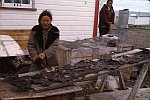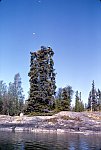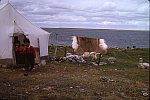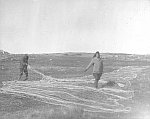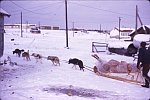Wildlife Management in Canada
Author: Anne Mease Page 1 | Page 2 | Page 3
Aboriginal Rights (Hunting and Fishing) in Canada
Aboriginal people have always had a special, if not sacred connection to their land and resources. The land and all it contains has provided a form of subsistence and sustenance to Aboriginal people for thousands of years. Prior to the arrival of Europeans as early as the 1500s and up to the signing of the Treaties from 1870 - 1921, Aboriginal people had free reign of territorial hunting grounds in the vast land of Canada. There were no lines of demarcation and each group based their territory on their subsistent need and availability of fish and game.
In Canada, under Sec 35 of the Canadian Constitution, 1982, Aboriginal refers to Indian, Inuit, and Métis (each group will be defined by their name-Indian is a legal definition and will be used interchangeably with First Nation). In Canada, the Numbered Treaties or Post Confederation Treaties were signed between 1871-1921 with the Government of Canada and 'Indian' peoples in Alberta, Northeastern British Columbia, Saskatchewan, Manitoba, and Ontario.
Treaty and Aboriginal Rights
The Canadian Constitution of 1930 included the Natural Resources Transfer Agreement (NRTA), " that the said Indians shall have the right, which the Province hereby assures to them, of hunting, trapping and fishing game and fish for food at all seasons of the year on all unoccupied Crown lands and on any other lands to which the said Indians may have a right of access."[13] Additionally, Aboriginal hunting and fishing rights are protected under Section 35 of the Constitution Act, 1982 and the Indian Act (1876).
Treaty or Status Indians by right of treaty or by right of registration under the Indian Act (1876) have Aboriginal rights to hunt or fish on reserve lands designated to them. For instance, Registered Indians can hunt and fish on
- "Indian Reserves, Wildlife Management Areas, Provincial Forests, areas of Provincial Parks where licenced hunting is permitted, unoccupied Crown lands, and other Crown lands where licenced hunting or trapping is permitted;
- Private land with the permission of the landowner or occupant; and Federal lands, such as community pastures and the Shilo Military Range, when such lands are opened to the public for hunting, or with the permission of the Pasture Manager or Base Commander."[14]
Additionally, Registered or Status Indians do not require
- Hunting or fishing licences;
- They are not restricted to specific seasons;
- and they are not restricted to bag limits.[15]
One of the biggest controversies surrounding First Nation peoples is the eagle feather that is used in traditional ceremonies. Because it is against the law to transport any wildlife or birds -in whole or in part (horns, gall bladders, hoofs, feathers) across provincial, territorial, or international borders without a license, First Nation people were prohibited from carrying eagle feathers into the United States where many of their traditional ceremonies occurred. However, "as of February 1, 2003, Status Indians from Canada who meet certain requirements may legally travel to and from the United States with lawfully possessed, personally owned eagle items for religious and cultural use" without obtaining a permit.[16] This exemption on carrying eagle feathers across borders does not apply to Inuit or Métis.
Land Claim Agreements and Aboriginal Rights
Land claims are modern day treaties settled between provincial and federal governments and specifically Indian or First Nation people who have not negotiated a treaty. There are currently 16 settled land claim agreements in Canada including James Bay Cree (Eeyouch) and Inuit peoples of Québec (1975), The Western Arctic Claim Inuvialuit Final Agreement (1984), Nisgha Final Agreement (1999) and Westbank (2003) in B.C., Tlicho Agreement (2003), ten in the Yukon Final Umbrella Agreement (1993-2005), Nunavut Land Claims Agreement (2001), and the Labrador Inuit Claim (2005). There are currently fifteen additional claims in Alberta, B.C. and Saskatchewan that are in the Agreement-in-Principle stage.
Land claim settlements as with Treaty acknowledge the special relationship that First Nation people had with their land, hunting and fishing, and environment. Each individual First Nation mandates hunting and fishing rights that are set out in the final agreement of land claims. As per their Constitution, they are responsible for creating their own hunting and fishing guidelines that can be based upon traditional forms of conservation or modelled upon an existing structure such as the Fish and Wildlife Conservation Act or a combination of both.
As with Treaties, land claim beneficiaries are restricted to hunting and fishing within their own territorial boundaries unless they have a Provincial or Territorial hunting and fishing license and follow Provincial or Territorial guidelines. First Nation people can hunt on another First Nation territory with written consent of the First Nation whose land is to be approached for hunting or fishing. This same rule applies to non-First Nation hunters and fishers who wish to hunt or fish on First Nation land settled by land claim agreement.
First Nations who hunt on their traditional territories are not restricted to bag limits or a set number of animals or fish that can be harvested providing that the game killed will be used for sustenance. It is however unlawful to hunt, kill, or capture certain animals such as musk-ox, white-tailed deer, or elk without a license.
First Nation cannot hunt game or catch fish to use their parts specifically for making arts and crafts for sale such as leather skins or jewellery but they can use parts of an animal that was killed in the process of procuring food for making arts and crafts for sale. Hunting and fishing can be done at anytime of the year to procure game for traditional uses such as Potlatches or other traditional ceremonies.
Métis and Aboriginal Rights
Métis are credited for inventing the Red river cart that enabled them to transport millions of pounds of buffalo meat a year to the fur traders in the 1800s. During the fur trade era, Métis as with everyone else, had unrestricted hunting and fishing rights. This is due in part to the lack of conservation laws or hunting and fishing regulations that did not exist.
Unlike First Nation and Inuit who have 'special' rights to hunting and fishing, Métis, do not have the right to hunt unrestricted as the other two Aboriginal groups because they did not sign Treaty or land claim agreements nor are they enrolled through the Indian Act (1876). At the same time that Treaty was taking place -1870-1921-Métis people in Alberta, Manitoba, and Saskatchewan were offered scrip. Scrip gave them a choice of 160-240 acres of land or $160.00-240.00 but it did not account for hunting and fishing rights. Evidently, " both the provincial and federal governments refuse to acknowledge special hunting or fishing rights for the Métis."[17]
Métis hunting and fishing rights are nonetheless becoming a realization but not without legal consequences. Before a Métis hunting and fishing right can be recognized it must first be challenged in a court of law as in the Powley Test (2003).
Steve Powley and his son Roddy were charged for hunting and killing a bull moose out of season but based on their Aboriginal right as understood in the Canadian Constitution (1982), they were exercising their right to hunt and fish-u nrestricted. After lengthy court proceedings it was found that " members of the Métis community in and around Sault Ste. Marie have an aboriginal right to hunt for food under s. 35(1)."[18]
However, the Powley Test did not mean that all Métis in Canada would have the right to hunt and fish unrestricted. Métis in other parts of Canada who wish to have their Aboriginal right acknowledged must first break the conservative rules and regulations setout in the Fish and Wildlife Conservation Act. Once charged with an offence, as in R. v. Powley, their case will be heard in a court of law where it will be determined if an Aboriginal right applies to the individual(s) involved.
In Saskatchewan, "Bruce Morin and Dennis Daigneault, two young Métis men from Turnor Lake, in the claim area, were charged with a number of fishing violations. Their case was defended in early 1995 in provincial court in Buffalo Narrows. A decision acquitting the two defendants was rendered in April 1996, on the basis that the scrip distributed in 1906 did not extinguish their aboriginal right to fish, which right was protected by s.35 (1) of the Constitution Act, 1982. On appeal, the Court of Queen's Bench in Battleford in September 1997 upheld that decision."[19]
This was an important decision for Métis in Saskatchewan (and elsewhere) because it is the first province to acknowledge that Aboriginal rights apply to all Métis in the province, not just in the region.
There is certain criterion that is required for defining Métis
- 'Métis' means an Aboriginal person who self-identifies as Métis, who is distinct from Indian and Inuit, and:
- is a descendant of those Métis who received or were entitled to receive land grants and/or Scrip under the provision of the Manitoba Act, 1870 or the Dominion Lands Act, as enacted from time to time; or
- a person of Aboriginal descent who is accepted by the Métis Nation and/or Métis Community (Amended Dec. 13/97). [20]
Aboriginal People and Wildlife Conservation
It is important to realize that being an Aboriginal person does not mean being exempt from persecution by Treaty or Land Claims when laws and guidelines set out in Fish and Wildlife Conservation Act, 1997 are broken. Certain rules and regulations apply to everyone in Canada including Aboriginal people to ensure that the conservation of all wildlife and biodiversity is protected.
According to The Rights and Responsibilities of First Nations People in Manitoba,[21]
Aboriginal people may not:
- hunt protected wildlife for which all hunting is prohibited, such as eagles, hawks, owls and polar bears;
- waste or abandon wildlife or fish;
- use or possess lead shot while hunting waterfowl;
- sell, trade, barter or give away fish or the meat or any part of a wild animal taken under status Indian hunting or fishing rights, except that food may be given to another status Indian person; (When you kill an animal for food you can use the non-edible parts to make traditional handicrafts for sale. However, you cannot kill an animal for the sole purpose of making items for sale)
- hunt or fish for species or in areas closed to all persons for specific conservation reasons;
- block more than two-thirds of a river or stream with a net or other device;
- fish within 25 yards of a fish ladder or fish-way;
- use nets or other methods of fishing other than angling, in stocked trout waters; transport fish in excess of a regular possession limit without a fish transportation loadslip, if the fish is going from the catch point to somewhere other than their closest residence.
Fish and Wildlife Rights (Protection) in Canada
Canada has taken lead in initiating programs that will ensure the protection and recovery of its endangered species. In 1976, the Committee on the Status of Endangered Wildlife in Canada (COSEWIC) was created by the Canadian Government along with wildlife officials to "assess scientific status reports on species and assign national statuses to species at risk." [22]
In 1992, Canada became the first country "to sign and ratify the United Nations Convention on Biodiversity." In this convention they agreed to "develop or maintain necessary legislation and/or regulatory provisions for the protection of threatened species and populations." [23]
The Accord for the Protection of Species at Risk, 1995 was initiated between Environment Canada and provincial wildlife Ministers to work jointly in creating policy and enforceable laws between provinces that would protect species at risk in all parts of Canada.
"The Accord outlines commitments to designate species at risk, protect their habitats and develop recovery plans. By endorsing its terms, governments acknowledge that no single jurisdiction can effectively protect species at risk. Partnerships are crucial. Governments have agreed to play a leadership role by developing complementary legislation, regulations, policies and programs to identify and protect threatened and endangered species and their critical habitats." [24]
Other organizations that are set up to protect endangered species include the Recovery of Nationally Endangered Wildlife Committee (RENEW), which has "overseen the development of merely 15 recovery plans for endangered species." [25] More recently, the Sierra Club of Canada helped form the Canadian Endangered Species Coalition to pressure the Canadian Government to enforce and create laws that would be honored by all provinces.
Until 1997, when the Canada Wildlife Act was repealed, not all provinces in Canada were concerned about having laws and regulations to protect endangered species. Provinces that have 'endangered species legislation' include Manitoba, New Brunswick, Prince Edward Island, Ontario, Nova Scotia and Quebec. While "Alberta and British Columbia have indicated that they do not plan to act to protect species at risk." [26]
The Species at Risk Act, (SARA), created by the Government of Canada in 2002 in conjunction with the Accord for the Protection of Species at Risk, 1995 and activities under the Habitat Stewardship Program for Species at Risk. Their goal is "to prevent Canadian indigenous species, subspecies, and distinct populations from becoming extirpated or extinct, to provide for the recovery of endangered or threatened species, and encourage the management of other species to prevent them from becoming at risk. More specifically, the Act will:
- establish the Committee on the Status of Endangered Wildlife in Canada (COSEWIC) as an independent body of experts responsible for assessing and identifying species at risk;
- require that the best available knowledge be used to define long and short-term objectives in a recovery strategy and action plan;
- create prohibitions to protect listed threatened and endangered species and their critical habitat;
- recognize that compensation may be needed to ensure fairness following the imposition of the critical habitat prohibitions;
- create a public registry to assist in making documents under the Act more accessible to the public; and
- be consistent with Aboriginal and treaty rights and respect the authority of other federal ministers and provincial governments.[27]
Protected Wildlife Areas in Canada
Nova Scotia: John Lusby Marsh National Wildlife Area--Sand Pond National Wildlife Area--Boot Island National Wildlife Area--Wallace Bay National Wildlife Area--Sea Wolf Island National Wildlife Area.
New Brunswick: Tintamarre National Wildlife Area--Portage Island National Wildlife Area--Shepody National Wildlife Area.
Quebec: Cap Tourmente National Wildlife Area--Îles de Contrecoeur National Wildlife Area--Îles de la Paix National Wildlife Area--Lac Saint-François National Wildlife Area--Pointe de l'Est National Wildlife Area--Baie de l'Isle-Verte National Wildlife Area-- les de l'Estuaire National Wildlife Area-- Pointe-au-Père National Wildlife Area.
Ontario: Big Creek National Wildlife Area-- Hahn Marsh Unit-- Mohawk Island National Wildlife Area-- Long Point National Wildlife Area-- Mississippi Lake National Wildlife Area-- St. Clair National Wildlife Area-- Wellers Bay National Wildlife Area-- Wye Marsh National Wildlife Area-- Prince Edward Point National Wildlife Area-- Scotch Bonnet Island National Wildlife Area.
Manitoba: Pope National Wildlife Area-- Rockwood National Wildlife Area.
Saskatchewan: Bradwell National Wildlife Area-- Prairie National Wildlife Area-- Stalwart National Wildlife Area-- St. Denis National Research Area-- Tway National Wildlife Area-- Webb National Wildlife Area-- Raven Island National Wildlife Area-- Last Mountain Lake National Wildlife Area.
Alberta: Blue Quills National Wildlife Area-- Meanook National Wildlife Area-- Canadian Forces Base Suffield National Wildlife Area.
British Columbia: Alaksen National Wildlife Area-- Widgeon Valley National Wildlife Area-- Columbia National Wildlife Area.
Northwest Territories: Polar Bear Pass National Wildlife Area-- Nirjutiqavvik National Wildlife Area.
Yukon Territory: Nisutlin River Delta National Wildlife Area-
Under Section 3.1 of the Wildlife Area Regulations, no person shall, in any wildlife area:
- hunt or fish,
- be in possession of any firearm, slingshot, bow and arrow, shot other than non-toxic shot or any instrument that could be used for the purpose of hunting,
- (b.1) be in possession of, while fishing, any lead sinkers or lead jigs that weigh less than 50 grams,
- have in his possession any animal, carcass, nest, egg or a part of any of those things,
- damage, destroy or remove a plant,
- carry on any agricultural activity, graze livestock or harvest any natural or cultivated crop,
- allow any domestic animal to run at large,
- swim, picnic, camp or carry on any other recreational activity or light or maintain a fire,
- operate a conveyance,
- destroy or molest animals or carcasses, nests or eggs thereof,
- remove, deface, damage or destroy any artifact, natural object, building, fence, poster, sign or other structure,
- carry on any commercial or industrial activity,
- disturb or remove any soil, sand, gravel or other material, or
- dump or deposit any rubbish, waste material or substance that would degrade or alter the quality of the environment, unless he does so under and in accordance with a permit issued by the Minister pursuant to section 4.[28] [Some of the above activities may be carried out with a permit issued under the authoritity of the Minister --Ed.]
Endnotes
[13] Constitution Act, 1930. <http://www.solon.org/Constitutions/Canada/English/ca_1930.html>
[14] Fishing, Hunting, & Trapping: The Rights
and Responsibilities of First Nations People in Manitoba
<http://www.gov.mb.ca/conservation/firstnations/huntingfishingjan03.html>
[15] Fishing, Hunting, & Trapping: The Rights and Responsibilities of First Nations People in Manitoba <http://www.gov.mb.ca/conservation/firstnations/huntingfishingjan03.html>
[16] Travelling to the United States with Eagle Items: Guidelines for Aboriginal People from Canada CITES <http://www.cites.ec.gc.ca/eng/sct4/note14_e.cfm#targ_4>
[17] Larue, Frank.Top Court to Determine Scope of Metis Rights. <http://www.firstnationsdrum.com/Spring2003/TrtyMetis.htm>
[18] R v. Powley. Supreme Court of Canada, 2003. <http://www.canlii.org/ca/cas/scc/2003/2003scc43.html>
[19] Métis Rights. Métis Nation-Saskatchewan. <http://www.metisnation-sask.com/rights/>
[20] The Definition of "Métis" Article 10 of the Métis Nation - Saskatchewan Constitution <http://www.metisnation-sask.com/rights/define.html>
[21] Fishing, Hunting, & Trapping: The Rights and Responsibilities of First Nations People in Manitoba <http://www.gov.mb.ca/conservation/firstnations/huntingfishingjan03.html>
[22] Fact Sheet on Endangered Species. Sierra Club of Canada. <http://www.sierraclub.ca/national/es/endang.html>
[23] Fact Sheet on Endangered Species. Sierra Club of Canada. <http://www.sierraclub.ca/national/es/endang.html>
[24] The Accord for the Protection of Species at Risk - Backgrounder. <http://www.speciesatrisk.gc.ca/recovery/accord_bac_e.cfm>
[25] Fact Sheet on Endangered Species. Sierra Club of Canada. Environment Canada <http://www.sierraclub.ca/national/es/endang.html>
[26] Fact Sheet on Endangered Species. Sierra Club of Canada. <http://www.sierraclub.ca/national/es/endang.html>
[27] Purpose SARA Public Registry: Government of Canada. <http://www.sararegistry.gc.ca/background/purpose_e.cfm>
[28] Section 3. (1) Wildlife Area Regulations, 1985
